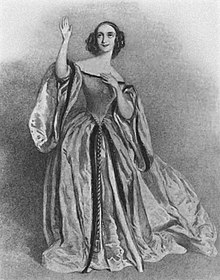
Back Лучия ди Ламермур Bulgarian Lucia di Lammermoor Catalan Lucie z Lammermooru Czech Lucia di Lammermoor Danish Lucia di Lammermoor German Λουτσία ντι Λάμερμουρ Greek Lucía de Lammermoor Spanish Lucia di Lammermoor Estonian Lucia di Lammermoor Basque لوچیا دی لامرمور Persian
| Lucia di Lammermoor | |
|---|---|
| Opera by Gaetano Donizetti | |
 Fanny Tacchinardi Persiani as Lucia in the London premiere in 1838 | |
| Librettist | Salvadore Cammarano |
| Language | Italian |
| Based on | The Bride of Lammermoor by Walter Scott |
| Premiere | 26 September 1835 Teatro di San Carlo, Naples |
Lucia di Lammermoor (Italian pronunciation: [luˈtʃiːa di ˈlammermur]) is a dramma tragico (tragic opera) in three acts by Italian composer Gaetano Donizetti. Salvadore Cammarano wrote the Italian-language libretto loosely based upon Sir Walter Scott's 1819 historical novel The Bride of Lammermoor.[1]
Donizetti wrote Lucia di Lammermoor in 1835, when he was reaching the peak of his reputation as an opera composer. Gioachino Rossini had recently retired and Vincenzo Bellini had died shortly before the premiere of Lucia leaving Donizetti as "the sole reigning genius of Italian opera".[2] Not only were conditions ripe for Donizetti's success as a composer, but there was also a widespread interest in the history and culture of Scotland. The perceived romance of its violent wars and feuds, as well as its folklore and mythology, intrigued 19th century readers and audiences.[2] Walter Scott dramatized these elements in his novel The Bride of Lammermoor, which inspired several musical works including Lucia.[3]
The story concerns the emotionally fragile Lucy Ashton (Lucia) who is caught in a feud between her own family and that of the Ravenswoods. The setting is the Lammermuir Hills of Scotland (Lammermoor) in the 17th century.
- ^ The plot of Walter Scott's original novel is based on an actual incident that took place in 1669 in Galloway, although Scott transposed the location to the Lammermuir Hills area of Lowland Scotland. The real family involved were the Dalrymples. While the libretto retains much of Scott's basic intrigue, it also contains very substantial changes in terms of characters and events. In Scott's novel, it is her mother, Lady Ashton, not Enrico, who is the villain and evil perpetrator of the whole intrigue. Also, Bucklaw was only wounded by Lucy after their unfortunate wedding, and he later recovered, went abroad, and survived them all. In the opera, Lucia's descent into insanity is more speedy and dramatic and very spectacular, while, in the book, it is more mysterious and ambiguous. Also, in the novel, Edgar and Lucy's last talk and farewell (supervised by her mother) is far less melodramatic and more calm, though the final effect is equally devastating for both of them. At the end of the novel, Edgar disappears (his body never found) and is presumably killed in some sort of an accident on his way to have his duel with Lucy's older brother; therefore, he does not commit a spectacular, operatic style suicide with a stiletto on learning of Lucy's death.
- ^ a b Mackerras, p. 29
- ^ Mackerras, p. 30